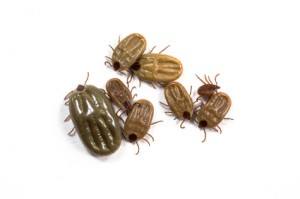Help! My Puppy Has Fleas and Ticks
If you are going to own a dog, fleas and ticks will become the bane of your existence. They migrate to dogs because of their fur coats and because dogs tend to lie down on the ground. Here is what you need to know if your puppy has fleas and ticks as well as what you can do to deal with these problems.

Causes of Fleas and Ticks
If there are fleas and ticks in your area, you can pretty much guarantee they are going to find your puppy sooner or later. It doesn’t matter if you have a dog with a thick coat of hair such as an Alaskan Malamute or next to no hair as is the case with Boxer puppies. This is unfortunate as they can make things miserable for your little fur ball. Given this, you need to understand what is loosely known as the “SFT” of this issue.
Symptoms of a dog with fleas:
- Biting
- Scratching
- Losing fur
- Sneezing
Flea health risks for your puppy:
- Allergies
- Scratching
- Hair loss
- Tapeworms
- Death (rare cases)
Tick health risks for your puppy:
- Lyme Disease
- Tularemia
- Ehrlichiosis
- Many other diseases
Of the above afflictions, I am of the personal view Lyme disease is the biggest threat. The disease is named after a town where it was first discovered. The disease consists of a bacteria that is transferred to the person through the saliva of the tick. The bacteria then flood the body through the blood stream where it will infect the brain and joints. Over time, it begins to degrade these areas and produces pain, depression and fatigue among other symptoms.
Fleas are annoying for a puppy, but Lyme disease can cripple and eventually kill a pup. I have a friend with an older Australian Shepherd pup who developed this disease from a tick bite. The poor pup was miserable and just laid around until it passed. It was very sad.

Prevention of Fleas and Ticks
As soon as you get your puppy, do an overall consult with a vet. They can take care of any issues the puppy may have and recommend steps you can take to handle fleas, ticks and any other threats particular to your area. You can also invest in a flea collar.
Next, give some thought to your yard. If you have weeds and high grass, it needs to go. Such conditions are paradise for ticks in particular and you are just asking for problems. Have the weeds yanked and the grass cut down to size. A clean yard means a clean dog.
When you head outside for a walk, hike or other event with your dog, make sure to check them when you come back. You can’t see fleas per se, but you should run your hands through their fur looking for ticks. They are usually fairly easy to find if they are present. Also, make sure to check the paws of your puppy for ticks, foxtails and other things wedged in there.
Preventive Treatments
There are a number of preventative treatments you can use to keep your puppy flea and tick free. They include products such as Frontline, Advantage and other brands. You do not need a vet prescription for these treatments. Having said this, it is critical to follow the directions on the packages. Most suggest not using these treatments for puppies under a certain age, often 8 weeks. I personally try to hold off even longer to 15 weeks or so if possible as these products contain fairly toxic chemicals. Still, I have used Frontline on my lab for years with good results.
After The Fact Treatments
The first step is to recognize you have an infested puppy. Now head to the pet store and buy flea and tick shampoo, a flea collar and a preventative treatment. Come home and wash the puppy as thoroughly as possible.
While you can get rid of the pests fairly easily, they leave behind eggs that hatch later on. Given this, you need to follow a regimen of washing your puppy with the shampoos as indicated on the particular product. I usually had at it every three days for two weeks with mine, but be careful as this can have a bad effect on their fur which is not meant to be washed all that often.
After cleaning your puppy, apply the preventative treatment if your puppy is old enough. If not, head to the vet and ask for something. They can take a look at your puppy and make safe recommendations.
Fleas and ticks are nasty. There is no way around this fact. The key is to take preventive action. You can do it. I live in a rural mountain area and my pup is fine. I use anti-flea shampoo once a month, Frontline and check for ticks after every walk. Follow this routine and your puppy will thank you.
Annie Klacks
@animaroo
